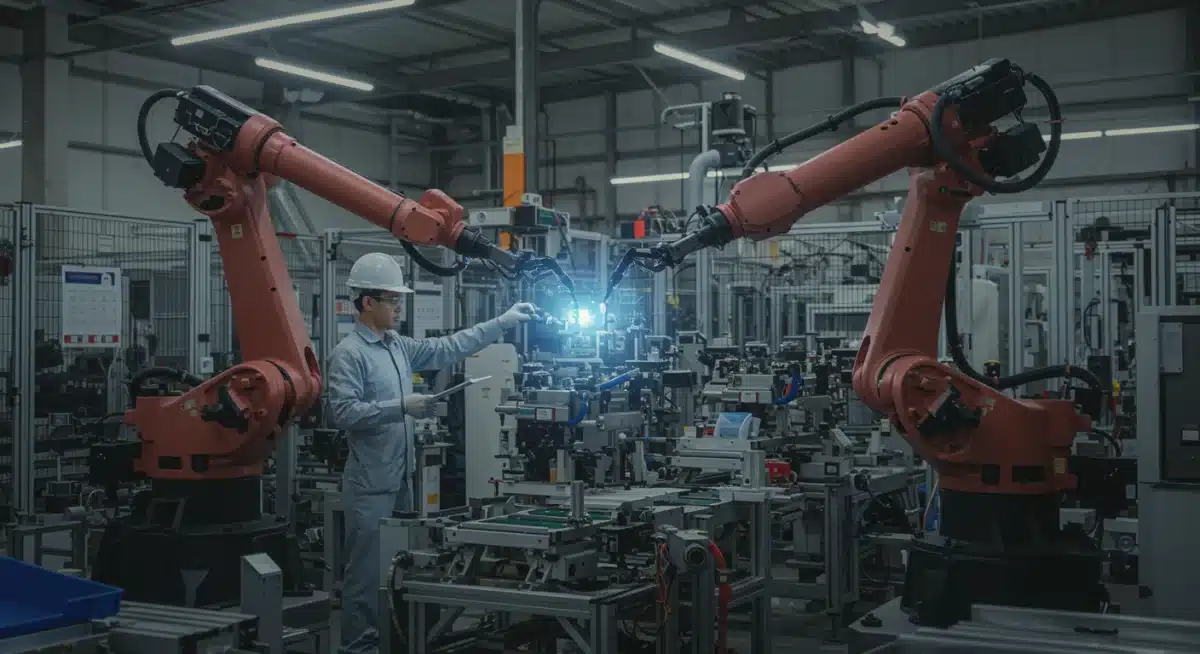The Next Decade: 25% AI Integration Across US Industries by 2034

As the technological landscape rapidly evolves, a groundbreaking prediction has emerged: The Next Decade: Predicting a 25% Increase in AI Integration Across US Industries by 2034. This significant surge is poised to redefine productivity, reshape job markets, and fundamentally alter the economic fabric of the United States. What does this mean for businesses and the workforce?
The AI Revolution: A Decade of Unprecedented Growth
The United States stands on the cusp of an unprecedented technological transformation, with artificial intelligence (AI) poised to become an indispensable component of nearly every industry. Recent analyses and expert forecasts indicate that by 2034, the level of AI integration across US industries is expected to jump by a remarkable 25%. This isn’t merely an incremental shift; it represents a fundamental re-engineering of how businesses operate, innovate, and compete on a global scale.
This projected growth is driven by several converging factors, including advancements in machine learning algorithms, increased computational power, and a growing understanding among business leaders of AI’s potential to unlock new efficiencies and revenue streams. The widespread adoption of AI tools, from automation in manufacturing to sophisticated data analytics in finance, is set to create a ripple effect across the economy.
Driving Forces Behind AI Adoption
Several key elements are accelerating the pace of AI integration. Businesses are increasingly recognizing the competitive advantages offered by AI, including enhanced decision-making capabilities and cost reductions. The demand for AI-powered solutions is also being fueled by a push for greater operational resilience and adaptability.
- Technological Maturity: AI technologies are becoming more robust and accessible.
- Economic Imperatives: Companies seek efficiency and competitive edge through AI.
- Talent Development: A growing workforce is skilled in AI implementation and management.
- Investment Surge: Significant capital is flowing into AI research and development.
Economic Impact: Reshaping Productivity and Growth
The anticipated 25% increase in AI integration is not just a technological milestone; it carries profound economic implications. Experts predict a substantial boost in productivity across various sectors, as AI automates repetitive tasks, optimizes complex processes, and enables more informed strategic decisions. This surge in efficiency is expected to contribute significantly to GDP growth over the next decade.
Beyond direct productivity gains, AI’s widespread adoption will foster new industries and services. The development and maintenance of AI systems, along with the data infrastructure required to support them, will create new economic opportunities. This includes a growing market for specialized AI consultants, developers, and data scientists, indicating a shift in the economic landscape and the types of jobs that will be in demand.
AI’s Role in Sectoral Transformation
Different sectors will experience AI integration at varying rates and with diverse impacts. Manufacturing, healthcare, finance, and retail are among the industries poised for the most significant transformations. For instance, AI in manufacturing could lead to predictive maintenance, reducing downtime and extending equipment lifespan. In healthcare, AI can assist in diagnostics, drug discovery, and personalized treatment plans.
- Manufacturing: Enhanced automation, quality control, supply chain optimization.
- Healthcare: Improved diagnostics, personalized medicine, administrative efficiency.
- Finance: Fraud detection, algorithmic trading, customer service automation.
- Retail: Personalized marketing, inventory management, customer experience enhancement.
Workforce Transformation: Jobs Evolve, Skills Shift
One of the most frequent discussions surrounding increased AI integration centers on its impact on the workforce. While concerns about job displacement are valid, a more nuanced perspective suggests a significant evolution rather than outright replacement. The 25% increase in AI adoption by 2034 will undoubtedly automate certain tasks, but it will also create new roles and necessitate a fundamental shift in required skill sets.
The demand for workers capable of developing, implementing, and managing AI systems will soar. Furthermore, roles requiring uniquely human skills—such as creativity, critical thinking, emotional intelligence, and complex problem-solving—will become even more valuable. The focus will shift from performing routine tasks to collaborating with AI, leveraging its capabilities to achieve higher-level outcomes.
Preparing for the AI-Driven Job Market
To navigate this evolving landscape, both individuals and institutions must prioritize continuous learning and skill development. Educational programs, corporate training initiatives, and government policies will play crucial roles in upskilling and reskilling the workforce. Emphasis will be placed on digital literacy, data analysis, and an understanding of AI ethics.
The move toward an AI-integrated economy requires proactive measures today. Businesses are beginning to invest in internal training programs, while educational institutions are adapting curricula to meet future demands. This ensures a smoother transition for the workforce and maximizes the benefits of AI.

Challenges and Ethical Considerations of AI Scale
While the benefits of a 25% increase in AI integration are substantial, the path forward is not without its challenges. Implementing AI on such a widespread scale raises significant ethical, regulatory, and societal questions that must be addressed proactively. Ensuring fairness, transparency, and accountability in AI systems is paramount to prevent bias and maintain public trust.
Data privacy and security concerns will intensify as AI systems rely on vast amounts of information. Robust frameworks and regulations will be necessary to protect sensitive data and prevent misuse. Additionally, the potential for algorithmic bias, if not carefully mitigated, could perpetuate and even amplify existing societal inequalities, warranting careful design and continuous monitoring of AI models.
Navigating the Regulatory Landscape
Governments and international bodies are already grappling with how to regulate AI effectively without stifling innovation. Striking the right balance between fostering technological advancement and safeguarding societal interests is a complex task. Discussions around AI ethics, responsible AI development, and liability frameworks are ongoing and will shape the trajectory of AI integration.
- Ethical AI: Developing systems that are fair, transparent, and accountable.
- Data Governance: Establishing robust policies for data privacy and security.
- Regulation: Crafting laws that promote innovation while mitigating risks.
- Bias Mitigation: Actively addressing and preventing algorithmic bias.
Sector-Specific Projections: Who Leads the Charge?
As the US marches towards a 25% surge in AI integration by 2034, it’s clear that certain sectors are poised to lead this charge, driven by their inherent data richness and operational complexities. Technology and finance sectors are already heavily invested in AI, utilizing it for everything from fraud detection to personalized customer experiences. Their early adoption provides a blueprint for others.
Healthcare is another sector expected to see dramatic shifts. AI’s ability to process vast patient datasets, assist in diagnostics, and accelerate drug discovery makes it an invaluable tool for improving outcomes and efficiency. Similarly, manufacturing, with its continuous drive for automation and optimization, will heavily leverage AI for predictive maintenance, quality control, and supply chain management.
Emerging AI Hubs and Industries
Beyond the traditional leaders, sectors like agriculture, transportation, and education are also beginning to explore and implement AI solutions. In agriculture, AI can optimize crop yields and manage resources more efficiently. Autonomous vehicles and smart logistics systems are transforming transportation. Education is seeing AI-powered personalized learning platforms and administrative tools.
This broad-based adoption underscores the pervasive nature of AI and its potential to revolutionize nearly every facet of the US economy. The diversity of applications highlights AI’s adaptability and its capacity to solve unique challenges across different industries.
Investment and Innovation: Fueling the AI Surge
The projected 25% increase in AI integration by 2034 is heavily underpinned by a robust and growing ecosystem of investment and innovation. Venture capital firms, corporate giants, and government grants are pouring billions into AI research and development, accelerating the pace of technological breakthroughs. This capital infusion is crucial for advancing AI capabilities and making them more accessible to a wider range of industries.
Innovation extends beyond just financial investment; it encompasses the continuous development of new algorithms, the creation of more powerful computing infrastructure, and the emergence of specialized AI talent. Research institutions and universities play a vital role in pushing the boundaries of AI science, feeding a pipeline of novel ideas and skilled professionals into the industry.
Key Areas of AI Investment
Investment is concentrated in several key areas that promise high returns and significant impact. These include machine learning platforms, natural language processing (NLP), computer vision, and robotics. Each of these sub-fields of AI offers distinct applications that are critical for driving the overall integration across US industries.
- Machine Learning: Core algorithms for data analysis and prediction.
- Natural Language Processing: Enabling human-computer communication.
- Computer Vision: Allowing AI to ‘see’ and interpret visual information.
- Robotics: Integrating AI into physical automation systems.
| Key Point | Brief Description |
|---|---|
| 25% AI Integration Increase | Projected surge in AI adoption across US industries by 2034, leading to significant economic shifts. |
| Economic Transformation | AI integration will boost productivity, foster new industries, and contribute to GDP growth. |
| Workforce Evolution | Job roles will evolve, requiring new skills in AI development, management, and human-centric tasks. |
| Ethical Considerations | Addressing challenges like bias, privacy, and regulation is crucial for responsible AI expansion. |
Frequently Asked Questions About AI Integration
For the average business, it signifies a widespread adoption of AI tools to automate tasks, optimize operations, and enhance decision-making. This will lead to increased efficiency, potentially lower costs, and improved competitive positioning across various industries and business sizes.
While AI will impact all sectors, manufacturing, healthcare, finance, and technology are projected to experience the most profound integration. These industries have extensive data sets and complex processes that are highly amenable to AI-driven optimization and innovation.
The job market will see significant evolution, with some tasks automated and new roles created. There will be increased demand for AI developers and managers, alongside a greater emphasis on human skills like creativity and critical thinking. Reskilling and upskilling initiatives will be crucial.
Key challenges include addressing ethical concerns like algorithmic bias and data privacy, establishing effective regulatory frameworks, and ensuring a smooth transition for the workforce through education and training. Cybersecurity risks also escalate with increased AI adoption.
Government policies are vital for setting ethical guidelines, establishing data protection laws, funding research, and supporting workforce development programs. They aim to balance innovation with societal well-being, ensuring AI benefits are broadly shared while mitigating potential risks.
What Happens Next
The projected 25% increase in AI integration across US industries by 2034 signifies a pivotal moment for the nation’s economic future. Moving forward, stakeholders from government, industry, and academia must collaborate to navigate the complexities of this transformation. We can anticipate accelerated investment in AI infrastructure, intensified efforts in workforce reskilling, and the emergence of more sophisticated regulatory frameworks. The coming decade will be defined by how effectively the US harnesses AI’s potential while addressing its inherent challenges, shaping a new era of productivity and innovation.



